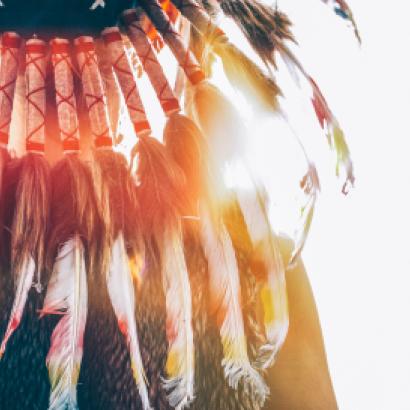"We've taken control of our destiny, gotten a taste of independence, and don't plan on giving it up. Government-led economies have been a total failure. I refuse to believe the Winnebagos are Karl Marx's last hope.”
Lance Morgan is the CEO of Ho-Chunk, Inc., a $100 million tribal economic development corporation that employs nearly 400 people. Tribal leaders and entrepreneurs such as Morgan are part of an economic civil rights movement emerging in indigenous communities around the world. The Winnebago Tribe of Nebraska, which owns Ho-Chunk, Inc., started with a casino, then diversified to earn the revenue needed to build the necessary infrastructure for prosperous tribal economies. Winnebago and other tribes following the same path have found a way to unlock the economic potential of their communities in ways of returning to their roots, consistent with their cultures and customs, while integrating into the modern global economy.
As explained in an earlier Defining Ideas essay, tribes are drawing on their history that is rich with the ideas defining a free society based on individualism, community, governance, and liberty. The indigenous peoples of what we now call the Americas were diverse, but they all had effective forms of property rights and governance structures that allowed them to specialize, trade, and prosper. These institutions and traditions of trade and treaty-making helped them to adapt and prosper before the Columbian Exchange and then to adapt and trade with the European newcomers.
After the Civil War, as America expanded west with its new standing army, indigenous institutions were undermined by the imposition of colonial institutions. Under these regulations, the federal government outlawed historic governance structures, rituals, and property rights and imposed cookie-cutter constitutions, modeled after the U.S. Constitutions, and held Indian resources—namely land—in trust on the premise that Native Americans were not “competent and capable” to manage their own lives and affairs. Despite a rich heritage of indigenous institutions that allowed them to prosper prior to and during early European contact, today’s American Indian communities, still locked in a type of colonial bondage as trustees of the federal government, are struggling economies.
Federal trusteeship in the 21st century is absurd, especially given that tribes have proven to outperform the federal government. Consider the land itself. When tribes manage their own natural resources, they do better than the federal government.
In 1995, the Confederated Salish and Kootenai Tribes (CSKT) on the Flathead Reservation in Montana compacted with the Bureau of Indian Affairs to take control of forest management decisions on the Flathead Reservation. Alison Berry (2009) documents the success of the experiment with resource management on the Flathead Reservation in Montana by comparing tribal forest management with U.S. Forest Service management on the neighboring Lolo National Forest. Not only did she find that the CSKT earned more than $2 for every $1 spent compared to the U.S. Forest Service just breaking even, Berry documents that timber quality, wildlife habitat, and water quality were all better under tribal management. In her words, “Since the CSKT rely on timber revenues to support tribal operations, they have a vested interest in continuing vitality of their natural resources…The tribes stand to benefit of responsible forest stewardship—or bear the burden of mismanagement.” (2009, 18).
The CSKT are not alone. Similar success stories can be found on the Yakama and Colville reservations in Washington, the Warm Springs Reservation in Oregon, and the Fort Bidwell and Hoopa Valley reservations in California. As per its treaty obligations, the federal government does contribute to the management of tribal forests. In national forests managed by the U.S. Forest Service, the federal government spends $9.51 an acre. Tribal managers, however, spend only $2.58 an acre. “These tribes are making profits and creating economic development and jobs from their forests,” points out Robert Miller in his book Reservation Capitalism, “and they are striving to preserve their ecosystems and sustainable growth for years to come.”
Despite compelling evidence that they are better suited to manage their resources, not all tribes enjoy the autonomy that the CSKT do. Consider the congressional testimony of Chairman A.J. Not Afraid, of the Crow Tribe of Indians, who points out that his tribe’s “land is rich in energy resources, natural resources, and minerals. So this topic is near and dear to the hearts and the pocket-books of the Crow people.” The Crow Tribe owns three percent of mineable coal reserves in the United States, but has only one active mine. That mine recently decreased its production by 50 percent because of what Chairman Not Afraid calls over-regulation that erodes the fabric of his community.
The Crow Tribe depends on coal tax and royalty revenue from this mine for up to two-thirds (2/3) of our non-Federal revenue annually, including essential Member services, such as care for elders, and basic infrastructure projects, such as road maintenance. . . .
Barriers to economic development cost Indians millions of dollars in lost revenue. Consider that if an Indian rancher – off the reservation – owns his own land, and wants to enter into an oil and gas lease, he can do so. The permits are fairly cheap, easy and quick to obtain, and he is free to make his own determination as to whether the agreement is in his interest. If the Crow Tribe wants to enter into an oil or gas lease – on land that the Tribe owns – we face a process of long wait times. We wait and wait and wait.
And what are we waiting for? We wait for permission from the federal government. By law, we need the BIA to bless our business contracts.
Energy resources, especially oil and gas, offer an economic incentive for tribes to reassert their property rights and sovereignty. On the Fort Berthold Reservation in North Dakota, the Three Affiliated Tribes have used special legislation to assert their control of oil and gas leases. The motto of Missouri River Resources, a tribally owned oil company, is “Sovereignty by the barrel.” As tribal chairman Tex Hall put it, “The potential here is to obtain financial independence for our nation, education for our youth, sustenance for our elders, maintenance of our culture and above all to set the people of the Mandan, Hidatsa, and Arikara Nation on the road to independence.”
Obstacles to Private Enterprise
The lack of independent businesses on the reservation means that when members of tribal communities do get paid, they spend most of their money off the reservation. Walmart’s biggest stores, in terms of sales per square foot, are at the edge of the Crow Reservation in Montana and the Navajo Nation in New Mexico. As former Deputy Assistant Secretary of Policy and Economic Development – Indian Affairs Gavin Clarkson points out, “Indian Country is America’s domestic emerging market, and as in other emerging markets, many successful businesses in Indian Country are starving for expansion capital while other businesses cannot even obtain startup capital. The U.S. Treasury estimates that the private-equity deficit in Indian Country is $44 billion.”
Many investors are reluctant to do business in Indian Country because of the perceived lack of political stability. While most tribes are reliable partners, a few bad actors have fueled the fears of potential investors, who face uncertainty about contract enforcement and loan repayment. A classic example is the Haulapai tribe’s tourist attraction called the Skywalk. When the crystal-clear glass bridge jutting over the Grand Canyon rim was nearly completed, the tribe claimed the developer had not met his obligations and took possession of the project. The developer tried to protect his interest, but was foiled when the tribe claimed “sovereign immunity” as a defense against its taking.
Very few tribal constitutions have restraints on government violating contractual obligations. Federal, state, and tribal governments frequently sign waivers of immunity in contract negotiations. Tribes also limit their immunity or sign full waivers, but tribes are also more often directly involved in business. Additionally, each tribal waiver must be considered individually due to the requirement for BIA approval for each and every contract involving trust land.
Clarifying Jurisdiction
Clarifying tribal jurisdiction is another necessary step toward creating governance structures for renewing indigenous economies. Jurisdiction not only defines the geographic boundaries that determine what land is under the laws of the tribe, but it also defines what economic activities are governed by tribal governments. Perhaps more importantly, jurisdiction over taxation is crucial for generating revenue to support governmental operations.
As the relationships between cities, counties, states, and the federal government suggest, land and economic activities can be under many difference jurisdictions. Land-use planning might be at the city level while water quality can be governed by the state or federal governments. Businesses are often licensed by local municipalities while product quality regulations are likely under the control of federal regulators.
In contrast to relatively clear jurisdictions under the umbrella of federalism as it applies to municipalities, countries, states, and the federal government, tribes have virtually no jurisdiction, let alone clear jurisdiction. Of course the boundaries of reservations are well defined, but the land within those boundaries is mainly under county and state jurisdiction if it is fee simple land and under federal jurisdiction if it is trust land.
Renewing Indigenous Economies
There are basically two diametrically opposed approaches to renewing indigenous economies, one that has the development agenda set by the federal government under the assumption that indigenous culture is inimical to, and an obstacle to, development; and the other that allows the tribe to establish its jurisdiction and governance structures, using property rights and individual initiative to fuel the economy. Where progress has been made in Indian Country, it is clear that the latter approach dominates the former.
Reducing the costs of defining and enforcing ownership claims, both individual and collective, and the costs of private and collective contracting, especially to obtain capital, is not easy for tribes, but it is essential if they are to emerge from their colonial economies. Crow tribal member, Bill Yellowtail (2006), succinctly describes what it takes to renew indigenous economies: “Indian sovereignty . . . is founded upon the collective energy of strong, self-sufficient, entrepreneurial, independent, healthful, and therefore powerful, individual persons. . . . The proper economic role for tribal government is to facilitate private enterprise . . . with an eye toward building the capacity of individuals and families to be truly independent.” These individual characteristics must be supported by institutions that emanate from the tribal level based on sovereignty and sound governance structures. Only then will tribes be able to renew their economies in the tradition of old indigenous economies.
If American Indians are ever to untie themselves from the bureaucracy that Ernest Sickey, former chairman of the Coushatta Tribe, calls “white tape,” they will have to renew their economies based on the three building blocks that made “old indigenous economies” prosper: well-defined and enforced ownership claims; clear tribal jurisdiction; and clearly enforced and stable rules of governance.
The Hoover Project on Renewing Indigenous economies is interested in advancing the ideas of a free society in and for Indian Country, but we share the sentiments of Bob Miller, author of Reservation Capitalism. “It is up to each tribal government, culture, and community to evaluate and select their own preferences…in deciding whether to make whatever systemic changes might be relevant to attract more investments.”
Sustainable economic development is not only consistent with their culture, it provides the economic resources to invest in the preservation of their culture with language education, community and cultural centers. It allows more people to raise their families on the reservation rather than move away for jobs.
The federal government must uphold its treaty obligations and continue to protect the treaty rights of tribes and their members. Treaty obligations to compensate tribes for the lands they ceded have morphed into the paternalistic provision of the goods and services Native Americans had always provided for themselves.
Breaking the cycle of dependency will not be easy, but as Clifford Lyle Marshall, Chairman of the Hoopa Valley Tribe, has said, “there is nothing traditional about having the federal government take care of us.” Government must get out of the way of the tribes that choose to renew their economies and their traditions to provide for their children.
Extracting themselves from colonial bondage requires defining tribal jurisdictions, establishing new governance structures built on a rule of law and tribal heritage, and securing property rights—both collective and individual—that help tribes fully participate in and benefit from the modern, global economy. In order to successfully attract investment and entrepreneurs, writes law professor Robert Miller, many tribes must “literally change the rules of the game.” Doing so means “it is up to each tribal government, culture, and community to evaluate and select their own preferences… in deciding whether to make whatever systemic changes might be relevant to attract more investments.”
As Herbert Hoover put it in 1944, “Every generation has the right to build its own world out of the materials of the past, cemented by the hopes of the future.” Native Americans deserve no less.
















